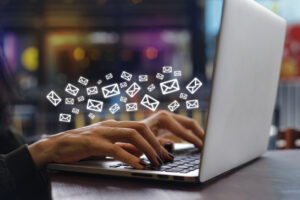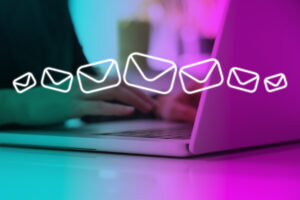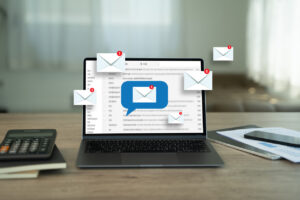10 ways for communicators to purge clutter and spark a digital detox
Try these tips to lighten your (work)load, lift your mood, and boost your productivity.

Are you a digital hoarder?
Massive amounts of files, tabs, docs and data can make you anxious and feel overwhelmed. It’s also distracting and can lead to information overload. Storing massive amounts of files and data can also present an increased risk of a cyberattack.
It’s like having a sink full of dirty dishes or a desk with a mountain of papers. It’s difficult to focus on anything else when you’re surrounded by clutter.
Try these 10 tips lighten your load, sharpen your focus and get that digital clutter under control:
1. Get your inbox in check.
Are you one of those people who constantly has 759 unread messages? Even if you’ve grown to ignore it, it’s always there, like a “check engine” light.
Right now, go through and clean out your inbox. You’ll feel better when it’s done.
Afterward, take these steps to keep your email under control:
- Set up rules, filters and labels to keep your inbox tidy and organized.
- Use Unroll.me or Sanebox to unsubscribe from unnecessary lists.
- Block off specific times of the day to check your inbox.
- If you have multiple email accounts, unify them so that you only have to go through one.
- Instead of typing out lengthy threads, use other communication mediums such as phone calls, texts, or Slack messages.
2. Keep your desktop clean.
Are you old enough to remember Windows 95? Remember how littered it was with icons — many of which were free trials or programs you’d never use?
There’s no need to live like that anymore. You can quickly access programs and files through a menu like Launcher (Chrome), Start (Windows), and Launchpad (Mac). That means that there’s really no reason to have distracting icons and shortcuts on your desktop.
Personally, my desktop is icon-free. But what about the programs you use the most? They are conventionally located in the taskbar at the bottom of your screen. Take a few moments to sweep those old docs into folders — or perhaps the trashcan.
3. Break up with old files.
It can be hard to part ways with old stuff. But, if you go through all of your old files, I guarantee that you can delete a bulk of them without losing a moment of sleep.
It’s understandable if this process can spike anxiety. “What if I need this spreadsheet from 2013?”
So, start nice and slow. Begin with deleting all duplicate files.
From there, tackle the oldest documents. If you absolutely cannot part with an old file, store your most treasured items on an external hard drive.
4. Use cleanup tools.
I use CCleaner, which eliminates cookies and your browsing history. It can also clear your cache and downloads, which can improve your device’s performance significantly. You can also try similar tools such as:
Other tools you can use to address bloatware are Clario and Should I Remove It? However, to do this right, you need to remove “bloatware” manually. If you don’t know how to do this, ZDNet has an article on how to do so if you’re using Windows 10.
Bonus tip: Delete bookmarks that you no longer need. For the ones that you do want to save, move them over to Evernote or Pocket.
5. Uninstall old apps and programs.
Remember when you made your desktop a minimalists utopia? Well, just because you deleted icons doesn’t mean that you completely uninstalled the apps or programs you no longer want. To get rid of them for good, you need to uninstall them.
The process will depend on the device you’re using. For example, it can be complicated if you’re using Windows 10. Head over to PCMag for advice on how to do this. It’s more straightforward if you’re using a Chromebook or Mac.
6. Be less social.
Social media can be a necessary evil. These platforms can be useful to network, spread brand awareness, and keep in touch with friends and family — just make sure they’re not destructive to you or damaging your productivity.
On average, we spend 145 minutes per day on social media. Considering that social media feels increasingly toxic and can negatively impact our mental health, don’t you think that time could be spent elsewhere?
While not everyone can permanently delete social media, at least cut back on the accounts you use. If you never go on Pinterest, then go ahead and delete your account. You should also defriend and unfollow people who are negative and only make you angry.
You can also reduce the time spent on social media by:
- Removing the apps from your smartphone so that you have to log in on the browser.
- Using time-saving social media tools such as Hootsuite or Sprout Social.
- Blocking social media apps and sites at specific times of the day.
- Setting time limits on how long you’ll be on social media each day.
- Use batching to check your channels only three times per day, such as before work, around lunch, and before ending the workday.
7. Cut back on the passwords.
According to a study commissioned by NordPass, the average person has 100 different passwords across various sites and services. The study states that there’s been an across as more people have searched for new services and entertainment during the pandemic.
Trying to remember all of these different passwords is no easy feat. However, using a password manager such as LastPass, Dashlane, or 1Password will securely remember these passwords for you.
I’d also recommend that you go through and delete rarely used accounts. Dormant accounts can cause security risks. You’ll also receive less junk mail.
JustDeleteMe is a directory of the most frequently used sites and how difficult it is to delete your account.
8. Free up space through defragging.
If your computer is dragging, you’ll probably need to defrag it to free up space. Most computers do this automatically. But, if not, you’ll want to create a calendar reminder to do this regularly. Or, you could use a took like Disk Space Fan.
Again, each OS is different. Here are some resources you can turn to if you still have trouble freeing up space;
- Ways to improve your computer’s performance
- Defragment your Windows 10 PC
- Free up space on your Chromebook
- Do You Need to Defragment a Mac’s Hard Drive?
9. Don’t forget about your smartphone.
Most of the tips listed above can also be applied to your smartphone. But here are some pointers you can use to declutter your phone.
- Deleting unused apps from your device.
- Moving apps that are frequently used from your home screen or placing them in “drawers.”
- Organizing apps by tasks, use or emojis.
- As opposed to saving files, use streaming services.
- Go through your photos and delete the ones that you would never share. As for the ones you want to keep, back them up and delete them from your phone.
10. Clean up your online calendar.
Your calendar app may not be eating too much digital space. But, if it’s jam-packed, how exactly will you squeeze in the time to handle your digital clutter? Besides, when you’re calendar is lean and mean, you’ll have more flexibility in your schedule — as well as enjoy your leisure time.
- Clean your calendar by removing unnecessary events.
- Sync your calendars so that they can be accessed from one place.
- Use color-coding so that you can quickly distinguish entries.
- Leave meetings without a purpose and back-to-back appointments off. The same goes for checklists, notes, and minuscule tasks.
Final words of advice
It’s easy to let digital clutter build up over time. However, if you let it pile up, it can affect your performance, productivity and health. It’s not the most exciting chore, but doing a digital detox is one step you can control toward pursuing better mental health.
John Hall is the co-founder of Calendar.







There are a few reasons why you should eliminate clutter from your desktop screen:
1. Any files saved to the desktop will be lost in a system restore.
2. Antivirus programs don’t typically screen documents and files saved to the desktop.
3. It takes longer for your system to boot up. Having only the required programs means your system is faster starting up.